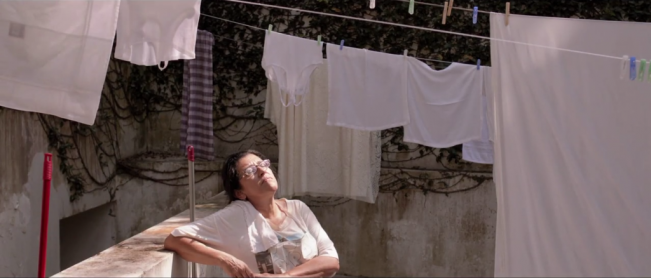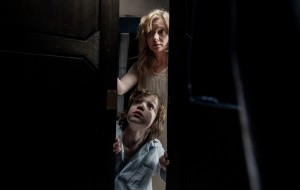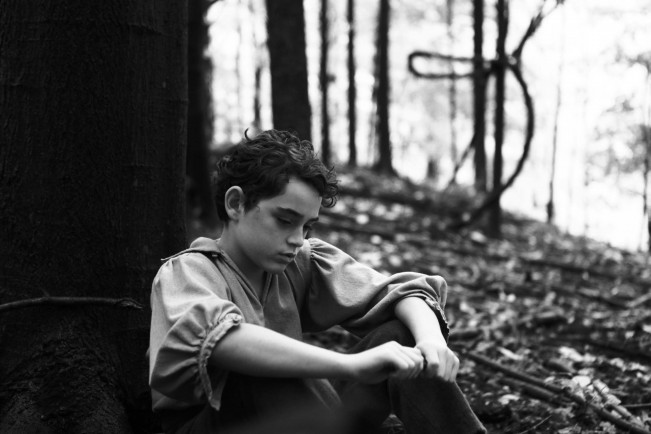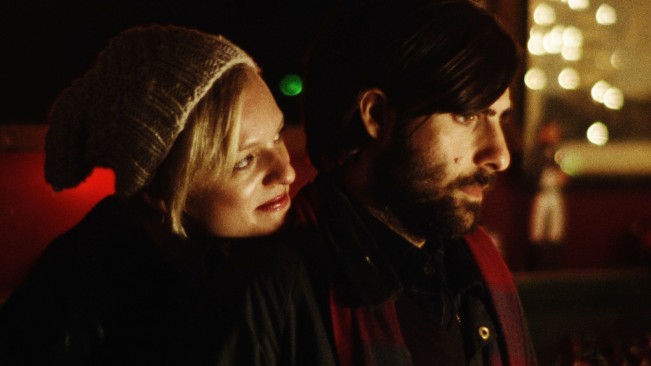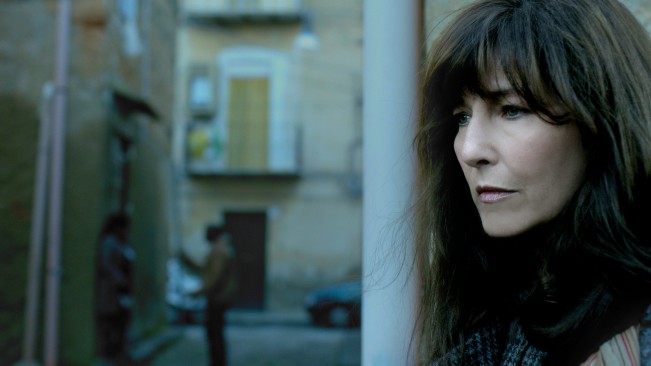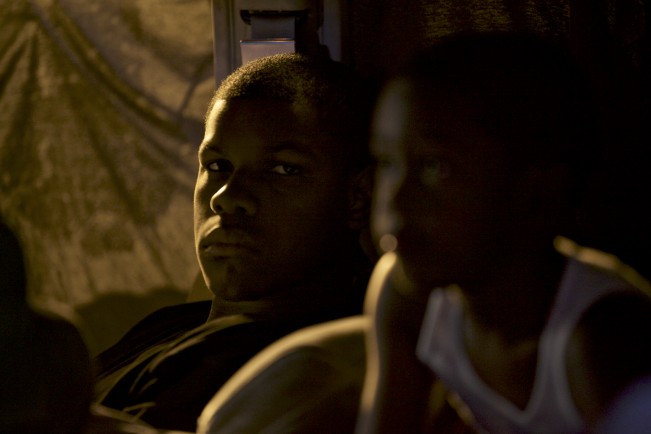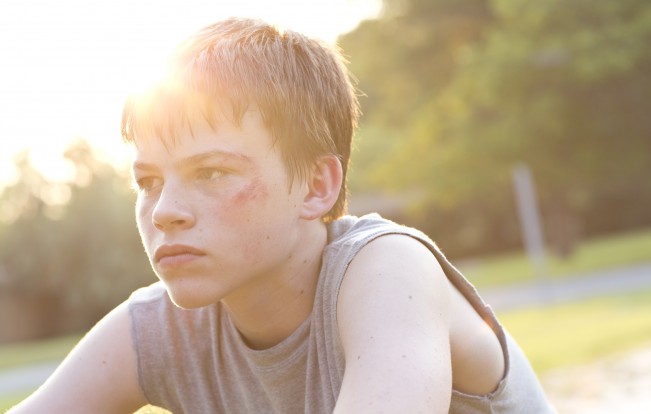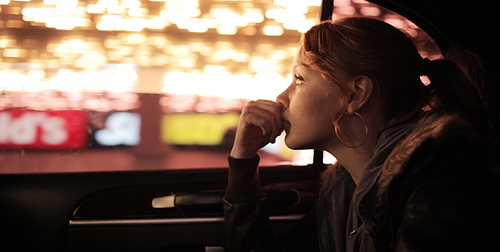Deep Astronomy and the Romantic Sciences
Described in the catalog as a “live science fiction event,” “Deep Astronomy and the Romantic Sciences” isn’t a Sundance film selection … quite. A long-gestating, global collaborative project by Sundance Fellow Cory McAbee, the two live performances (aka masterclasses) presented at Sundance 2018 are pieces of a whole that were being filmed for inclusion, ultimately, in a feature film project that will emerge at the end of this long gestation. Confused yet? It’s okay, so was the guy at the Q&A for the first performance of Deep Astronomy, who thought he’d bought a ticket for a master class on … well, actual astronomy.
Deep Astronomy marks McAbee’s fifth Sundance appearance, something not a lot of people can claim. His first short film, Billy Nayer, premiered at Sundance in 1992; McAbee built live performances around the short and came back to Sundance in 1995 with its first multimedia event, The Billy Nayer Show. McAbee followed that project up with a feature script The American Astronaut, which was accepted into the Sundance Screenwriters Lab and debuted at Sundance 2001, and then he returned again in 2009 with Stingray Sam, a series intended for distribution on multiple platforms.
Deep Astronomy is masterclass in two parts with an intermission in between; McAbee bounces energetically on stage in front of the audience, seamlessly shifting back and forth between singing songs and “lecturing” about transdimensionality, the Romantic Sciences, the stardust that comprises us, and the metaphorical relationship between you, a butterfly, a cotton ball soaked in ether, a jar, and the pin that holds the butterfly’s corpse. In the second half of the show, he delves into even headier topics like the feasibility of interplanetary relocation and … alternative burial methods.
It’s all very strange, strangely compelling, and completely mesmerizing. Are you the butterfly? McAbbe asks? Or are you the pin, or perhaps the jar? You may not come out of Deep Astronomy knowing the answer to that question, but you’re sure to find yourself pondering the show after experiencing it.
Spheres: Songs of Spacetime
The honor of the first-ever sale of a VR project at Sundance will go down in the annals of VR history as belonging to Spheres: Songs of Spacetime, the sophomore effort of 26-year-old science geek/storyteller whiz kid Eliza McNitt, who had her first big VR project, Fistful of Stars, at SXSW last year.
Spheres was a lovely and interesting way to experience deep space, and McNitt is a cool chick who’s deeply interested in space and science, but the team still has work to do in more tightly defining its storytelling aspect. I interviewed both McNitt and exec producer Darren Aronofsky about Spheres and how Aronofsky’s team worked with McNitt on defining the hero’s journey” off the piece, and there’s certainly more storytelling here than in Fistful of Stars, but as this is intended to be one piece of a three-part series, I’m hopeful they’ll find a way to tighten up the story and deepen the experience even more. The illusion of immersion into deep space is super effective for the most part, and I found Jessica Chastain’s narration of the piece very calming and soothing as it guided my journey.
I do hope they work on an aspect of Spheres I didn’t enjoy; around the two-thirds point of the experience there’s some multi directional motion stuff happening that made me quite nauseous and then gave me significant vertigo, so much so that I almost fell over. I experience a great many VR projects and I very rarely get motion sickness, so I found this pretty concerning, even more so after its high profile sale. Casual conversation on the ground at Sundance convinced me that it wasn’t just me.
Now that the project has been bought and, to some degree, can potentially set a bar with investors, I hope CityLights will incorporate some U/X testing as they tighten up the series, too. This piece, whether it’s ultimately experienced in homes or museums, needs to not induce motion sickness or vertigo before it’s out to the VR newbie masses.
Wolves in the Walls, Chapter 1
One of the most anticipated pieces at New Frontier was Wolves in the Walls, based on the award-winning 2003 book by Neil Gaiman and Dave McKean. The project, a “VR fable about the nature of fear,” was created by Lead Artists Pete Billington and Jessica Shamash, with Key Collaborators Edward Saatchi, Saschka Unseld, Jennine Willett, and Zach Morris, and is the first part of an intended episodic adaptation of the book, which is about a little girl who has nightmares about wolves living inside the walls.
The experience puts you alongside Lucy, and builds on work begun by the folks at the now-defunct Oculus Story Studio around interactivity with characters in VR settings. Lucy looks at you, talks to you, more or less reacts to you. Your mileage may vary as to whether you find the interactivity with Lucy meaningful, and whether the interaction with objects in the experience helps or hinders your own suspension of disbelief.
For me, it was distracting from the story, and I couldn’t help but think as I was going through it that Lucy as a character brought to life in this piece reminds me more than a little of Dora the Explorer, a character my own kids adored, even as I found her nauseatingly twee. The tone of the artwork overall in the VR piece also, and especially the character of Lucy, struck me as being a lot lighter and kid-TV-channel friendly than Dave McKean’s darker illustrations in the book.
If I’m looking at Wolves in the Walls in the context of it being a piece of work aimed at children as its primary intended audience, then I’d say the interactivity with both character and objects is fine, if a bit awkwardly experimental. However, if I’m looking at it from my perspective as an adult who’s experienced a lot of VR projects over the past three years, who’s seen the space evolve and develop, this for me is at best an experimental prototype in how to integrate interactivity into a VR piece without disrupting story flow or suspension of disbelief that doesn’t quite hit its mark.
The things you’re given to do in Wolves in the Walls – picking up objects and interacting with them – were being explored through projects like Christine Berg’s Wonder Buffalo this time last year, although the virtual Polaroid camera was admittedly cute and fun to play with. If I’d had a chance to go through Wolves a second and third time, though, I would have tested whether the camera lets you take pictures of anything you actually point at (true interactivity) versus only spitting out pictures that it wants you to take (faux interactivity) and even what would happen if I tried to take a picture of myself. Those experiments will have to wait for another day. Wolves in the Walls is anticipated to be a three-part series on Oculus, so I’ll have a chance to see if it all comes together eventually.
Experience Touch in Virtual Reality
It can’t properly be considered a “project” so much as a demonstration of technology, but Experience Touch in Virtual Reality by startup HaptX is a very cool demonstration of something the VR industry as a whole has been waiting to see fully evolve: haptics, or the ability to “feel” things (or in essence, to trick the brain into thinking you feel things) in virtual reality.
The two HaptX stations at the New Frontier space at The Ray demonstrated the capabilities of the technology HaptX has developed by having you interact with a number of virtual objects that allow you to “feel” things on your hand that aren’t really there: An apple (round shapes). A cube (edges and corners). A spider crawling on your palm. Heat and cold.
It may not be a project per se, but what HaptX demonstrated at Sundance is a relevant demo of where the technology is heading, and if you’re a storyteller or VR artist, it should definitely spur your imagination to think about the ways you’ll eventually be able to enhance the audience’s interaction with immersive storytelling through touch.
Chorus
Tyler Hurd’s 2017 VR project Chocolate was a brightly colored, psychedelic experience featuring brightly colored cats that you shot out of cannons on your arms. Chorus, Hurd’s latest project, presented by Within (the production studio of VR “thought leader” Chris Milk) and Annapurna Pictures, is a multiplayer game you play with six people at once. The premise is that each of the players randomly are assigned the avatar of one of six “female-ish” warriors and you just kind of fly through the game together, to the track “Chorus” by popular EDM group Justice, aka Xavier de Rosnay & Gaspard Augé.
Hurd has been exploring what music videos might be in VR for a while now, trying to figure out the right combination of immersivity and interactivity as he pushes against what our conception of “music video” is and can be in this space; I can kind of see what he’s aiming to get at, and yet both Chocolate and Chorus leave me feeling that Hurd’s not quite there yet with figuring out what the term “music video” even means within a fully immersive and interactive context, and his content, stylistically speaking, is feeling very one-note.
For the Sundance installation of Chorus, described as an “epic ‘80s fantasy movie” experience, I was escorted into the installation space with five strangers, each of us assigned to a cubby and helped into bulky haptic vests and headsets. We were instructed by friendly docents to talk to each other, sing, dance, interact, and above all, not to be self-conscious about it. Essentially, here’s what happens in Chorus: the Justice song plays (it’s a solid EDM track, so props there) and now you and the other five players are all very stylized female “warrior” type characters.
The experience of Chorus is one of constant motion as all six warriors are kind of surfing and zooming through this imaginary universe, and the idea is that you’re fighting off monsters by shooting lasers from your arms (lasers instead of cat cannons, same basic idea underlying the graphics) as you dance. You can’t control the speed at which you’re moving through the experience, and it takes you through it so quickly that there’s really not time to properly take in and observe the world you’re in long enough to really suspend disbelief, or even to really look at the other avatars much.
From the start I was so focused on trying to absorb everything that was moving around me that I quickly felt frustrated at the forced speed of the pace and especially the lack of ability for me to control that. It was rather like being shoved down a long, long slide with many trippy visuals around you; if I had had time to do it a second time being aware of that, I probably would have tried to just relax more and go with the flow rather than fighting against the constant sense of motion in the piece. On the plus side, it at least didn’t give me motion sickness.
I interacted verbally with my group and they were chatty overall. Lots of oooohs and ahhhhhs and “check out my lasers guys!” and that kind of stuff. But the structure of the experience is such that while you are experiencing it socially with these other people, you’re not truly interacting with them, as the only real interactivity with each other is yelling over the music. It feels kind of like trying to talk to your friends in the middle of a dance floor during a rave while the music’s popping. There’s not a way for the players to interact physically with each other, or to cooperate in doing things physically within the experience, at least not that I found during the duration of my time in it.
Chorus evokes Chocolate visually, with lots of bright colors and trippy animation, not unlike what I would imagine it would feel like to fall into my vintage ‘80s Lisa Frank binder while on psychedelics; I suppose there’s something to be said for owning a particular artistic sensibility around your work, but cutesy aesthetics aren’t enough to make a VR experience compelling.
If you’re going to sell me that you have a six-player “epic ‘80s fantasy” experience featuring female warriors, man, I want some interactivity with that that goes beyond white-labeling last year’s cat cannon functionality reworked to shoot lasers out of my arms, and I want some story and character development that makes the female warriors feel actually incepted out of story and a hero’s journey, with enough substance wrapped around the experience to give me a connection to my character and the other avatars and to care why we are there.
From a U/X standpoint this project seems to be roughly be trying to build upon the U/X of both Chocolate and the 2017 Chris Milk/Within entry The Life of Us, a two-player experience in which the player “ran” through the entirety of evolution, assuming various evolutionary forms along the way, with the shifting avatars mapped to your body such that you could move your arms (or flap your wings) and kind of interact with the other player. Here you wave your arms around and shoot lasers, there are six people instead of two, and your avatar never changes. Same basic concept underneath, though, painted a very slightly new way.
I was left with the impression of being profoundly disappointed that a project like this, produced by both Within and Annapurna, incepted by Tyler Hurd (who has now had the good fortunate to have his work featured both at Sundance and SXSW), and presumably with some funding to actually create something really cool, didn’t push against the fabric of the technology more than Chorus.
All that talent and experience, presumably a project that actually had some decent financial backing and budget to work with, and the end result was profoundly underwhelming. Within is starting to feel like the Emperor who isn’t wearing any clothes, while the denizens keep ooohing and ahhhing over nothing much at all.
VR-I
On the other side of the room from Chorus, I checked out VR-I, a project that explored interactivity far more effectively. VR-I is a collaboration between Swiss choreographer Gilles Jobin and the founders of Artanim, Caecilia Charbonnier and Sylvain Chagué (who were at New Frontier in 2016 with Real Virtuality, the first two-player VR piece I experienced at Sundance.
VR-I (yes, they could use a better name for this experience if it ever moves beyond the experimental and into the realm of monetization) is a deliberate exploration of multi-player interaction, and I found it infinitely more interesting and engaging than Chorus. VR-I was untethered, meaning the experience was run via laptops we wore in backpacks, and the five of us in the group together were free to move around the room and each other as we interacted with the content and with each other.
Once we were all settled in and in headset, a docent’s voice in our ear told us to try high-fiving each other. We did, and the latency-free result encouraged us to do more; soon we five strangers were spontaneously joining hands to dance in a circle and making a “soul train” style avatar fashion show.
The construct of VR-I plays considerably with scale and movement and encourages the group to move around and interact with each other and with the NPCs. It’s not a flashy piece, there’s no cats or laser cannons, but VR-I effectively explores the way a true multiplayer interaction within and immersive and interactive setting might work.
My one issue with VR-I was the backpack; the laptop powering the experience is heavy, and the docent didn’t know how (or just didn’t take time) to adjust the straps on each person to ensure the proper balance of the weight of the backpack with each person’s center of gravity. Consequently several of my group were complaining of the backpacks weight and it hurting their back while we were still in the experience, and the small of my own back was very sore for several days after. That’s not a good thing, and something the VR-I team needs to spend more time evaluating with user testing and fixing. Overall, though, while VR-I still feels more like a prototype than a ready-for-prime-time anything, it’s pretty cool and it’s a terrific exploration of the potentialities (and drawbacks) of multiplayer untethered VR experiences.
TendAR
At first glance TendAR is an odd choice for New Frontier; essentially it’s an app that demonstrates capturing human facial expressions to feed information to an AI database, which is generally something I think of in a marketing context; the preamble to the experience even touts it as the future of marketing, which makes it something that would seem more in context on the convention center floor at SXSW than at a prestigious film festival.
AI tech that reads and interprets facial expressions is also important, though, in the context of interactive storytelling and figuring out how to architect story with a fully immersive environment, so examining TendAR from that perspective, it’s not completely out of context here.
Consider Wolves in the Walls. If that experience was integrating the kind of facial expression reading demonstrated in TendAR and feeding that information in real time to an AI-driven script being written on the fly from a finite set of choices, such that the interaction with the character and even direction of the story were being generated dynamically, that would be super compelling. It would also be a way to make interaction with CGI characters feel more “human” because a dynamically generated story would be able to respond and react to the feedback it gets from you faster and in a way that more closely mimics actual human interaction.
What TendAR in its present exhibition at New Frontier shows is the potentiality of a piece of emerging tech that will, perhaps sooner than you think, change the way we can both write and experience story. Look at it from that context rather than as a purely marketing thing, and it makes more sense that it was here
DickGirl 3D(X)
DickGirl 3D(X), the piece at New Frontier that seemed, on the surface, to be the most baffling, turned out to be the most relevant and provocative piece showing among this year’s New Frontier VR installations, and perhaps the only one that I’d file under the designation “contemporary art.”
The very nice docent at the door of the DickGirl 3D(X) installation at New Frontier at Kimball Art Center looked up hopefully as I approached. “Would you like to experience DickGirl?” she asked brightly. “I’m not sure I… would I? What’s it about?” I said, curious how she’d respond. The friendly smile turned up a notch. “It’s probably easier for you to experience it yourself than for me to explain it.” She walked into the installation, leaving me no choice but to follow.
The docent suggested I sit on a comfy mat on the floor (er … not sure I want to sit on a mat where hundreds of people have been watching this X-Rated experience / digital art piece, but okay sure, just gonna trust that it’s well-sanitized between users and sit right down). She helps me into the headset, tells me the experience is running on a three minute loop, and quickly makes her escape. Now it’s just the two of us in here, it’s me and DickGirl and an amorphous blob and a three-minute loop abstractly exploring body, sex and consent..
I stayed in for 10 loops. 30 minutes of simulated cyberfucking. By about the fourth or fifth loop, I got it.
So what exactly is DickGirl 3D(X)? Google “dickgirl” and you’ll get a ton of variations on a similar theme, mostly pulled from hentai, a subset of Japanese anime featuring perverse acts / anime porn. At its simplest and most literal, DickGirl 3D(X) is a genderless (or maybe dual-gendered is a better word) humanoid modified from the Eva 3.0 avatar, a glowing white being with large breasts and a giant, electric blue, pulsing, throbbing dick. For the three minutes of the experience, DickGirl pleasures itself both on and with a large blob of not-very-sexy, non-reactionary, compliant grayish digital clay. If you sit and watch it on a loop three or four or ten times, as I did, the experience begins to feel like an abstract experiment in deconstructing arousal, porn and the body in digital space.
DickGirl 3D(X) was created by the London-based artist Sidsel Meineche Hansen, who’s known for a body of work deeply exploring the body and capitalism, and virtual space as an extension of capitalist economy. DickGirl 3D(X) was exhibited back in 2016 as a part of an exhibition at Gasworks in London called “Second Sex War,” which featured this piece displayed on a monitor suspended from a wooden BDSM cruciform. DickGirl 3D(X) replicates fucking from the various “pose sets” that come programmed into the Eva avatar. The amorphous, genderless blob wraps itself around DickGirl, who pulls at its flexible blobbiness and moves through a wide array of simulated sexual positions viewed from many perspectives, slices of a digital sexual experience revealed in angles and moans and patterns of breathing.
Ultimately DickGirl 3D(X) dissects digitized sex and explores the commoditization of the human body and the sex act, and I found it to be the most originally incepted piece of digital art I experienced at New Frontier this year. It’s a bold and daring choice, an unapologetic placement of contemporary art in the midst of a lot of tech + art experimentation.
DickGirl 3D(X) in this program is exactly why Shari Frilot has the position of head curator of New Frontier. This is the kind of weird, challenging art that I want to see a festival like this putting out there; it simultaneously challenges both societal notions of the body and sexuality, and explores a more provocative and controversial theme through art.





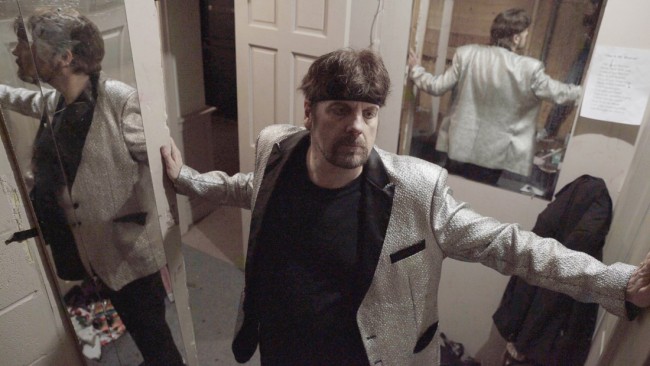
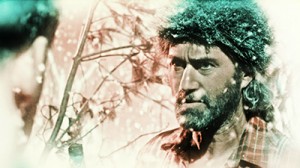 If there’s a director at Sundance who would view assertions that his film garnered the most walkouts of the fest as an indication he succeeded in making the film he intended, it’s Canadian director Guy Maddin, here this year with what I consider his finest and most layered work yet, The Forbidden Room. Known for making trippy, weird stories that are both deeply personal explorations of philosophical ideas, Maddin works in layers of abstract visual poetry. Recline in your seat, breathe in, breathe out, and allow the imagery to flow into you as you try to take it all in; you’re peering directly into Maddin’s brain through the lens of his camera, and given the recurrence of the idea of “brain” throughout his work, that’s about as meta as you can get.
If there’s a director at Sundance who would view assertions that his film garnered the most walkouts of the fest as an indication he succeeded in making the film he intended, it’s Canadian director Guy Maddin, here this year with what I consider his finest and most layered work yet, The Forbidden Room. Known for making trippy, weird stories that are both deeply personal explorations of philosophical ideas, Maddin works in layers of abstract visual poetry. Recline in your seat, breathe in, breathe out, and allow the imagery to flow into you as you try to take it all in; you’re peering directly into Maddin’s brain through the lens of his camera, and given the recurrence of the idea of “brain” throughout his work, that’s about as meta as you can get. Maddin, working here with his co-director/prodigy/researcher Evan Johnson, weave together interconnected snippets of many different stories, intricately nested within each other like a cinematic matryoshka doll in which each new layer unfolds with its own brilliant palette to assail your senses as their stories dance around and through each other: the crew of a submarine, trapped and running out of oxygen but afraid to disturb their captain, desperately chews flapjacks to release the air bubbles and survive; a lost woodsman mysteriously appears to tell the tale of a fearsome clan. Skeleton women! Kidnapping! Amnesia! Murder!! And of course, Mother … Mother. Always watching!!!
Maddin, working here with his co-director/prodigy/researcher Evan Johnson, weave together interconnected snippets of many different stories, intricately nested within each other like a cinematic matryoshka doll in which each new layer unfolds with its own brilliant palette to assail your senses as their stories dance around and through each other: the crew of a submarine, trapped and running out of oxygen but afraid to disturb their captain, desperately chews flapjacks to release the air bubbles and survive; a lost woodsman mysteriously appears to tell the tale of a fearsome clan. Skeleton women! Kidnapping! Amnesia! Murder!! And of course, Mother … Mother. Always watching!!!
